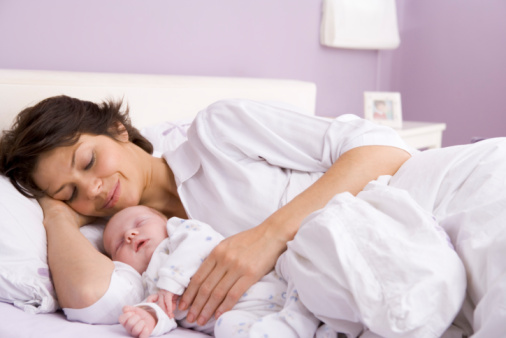The UK based study, entitled “Bed sharing when parents do not smoke: is there a risk of SIDS? An individual level analysis of five major case–control studies”, by Carpenter et al 2013 is a meta-analysis of 5 case studies from the 1990s conducted across the UK, Europe and Australasia. The objective, as laid out in the paper published in the BMJ Open, was to resolve uncertainties surrounding supposedly safe co-sleeping. For the purpose of the study, this is considered as being a breastfed baby bedsharing with non-smoking parents. The study concluded that, smoking and breastfeeding aside, bedsharing increases the risk of SIDS by up to five times. Naturally, this has left many parents feeling confused and anxious.
SIDS has long been considered a mysterious event, with no one identifiable cause despite many years of research. For anxious parents, research can be highly influential with the Back To Sleep campaign, launched in the early 90s, being responsible for SIDS rates falling by as much as 50%. Criticisms for the Carpenter et al study suggest that their conclusions may lead to exhausted parents falling asleep with their babies in even riskier places, such as sofas and armchairs.
So, what exactly did this study find?
Looking at 1472 SIDS cases compared with 4679 controls, researchers found an increased risk of SIDS in varying situations. They noted an increased risk through parental use of illegal drugs, alcohol and smoking and a risk was noted for bottle-fed babies regardless of sleeping arrangements. They also determined a dramatically increased risk when parents slept with their babies on a sofa or chair. However, these findings aside it was also discovered that babies are at an increased risk of SIDS, in babies under 3 months of age, when neither parent is a smoker and baby is breastfed, but is bedsharing. In babies over 3 months, no difference in risk was found.
Taking a closer look
Criticisms for the findings have been widespread, with flawed methodology being the main concern. The study, despite a large number of missing variables, attempts to suggest that correlation implies causation. Put simply, this is not good science. Though the conclusion is indeed valuable, many of the missing variables make for important points of discussion.
One of the most important factors missing in the research is whether or not bedsharing was planned or unplanned. A parent planning to co-sleep with their baby is significantly more likely to employ safety techniques than a parent who has fallen asleep, accidentally, due to exhaustion. A previous study by Venneman et al (2009) found no increased risk when co-sleeping was planned. Furthermore, no indication was given as to whether or not the mattress and bedding involved was suitable for co-sleeping which is much less likely to be a factor, as previously mentioned, in planned co-sleeping.
Other important points that are missing from the study include whether or not the mother smoked in pregnancy, whether or not she was using prescription medications (as many mothers are, post c-section), how many other people were in the bed at the time (or who they were) and, importantly, whether or not the baby was premature (a known risk factor for SIDS).
Alternative theories
In countries like Japan, where safe co-sleeping techniques are commonly employed, the SIDS rate is actually dramatically lower than rates within the western world. This was noted in a 2009 study by Nelson et al and is considered the most normal sleeping arrangement for mother and baby throughout human history.
The potentially protective effect of cosleeping has been noted in various studies (Mosko et al 1997; Mao et al 2004; McKenna and McDade 2005; McKenna and Volpe 2007) with theories behind why ranging from baby experience more frequent sleep arousals (apneas [a pause in breathing] have been attributed to SIDS deaths and fewer sleep arousals heightens the risk of these episodes) to the mother being close enough to notice respiratory distress.
It has also been noted that breastfeeding may have a protective effect against SIDS in the 2009 Venneman et al study.
What to take away from this study
Whilst the findings are subject to significant criticisms, it is important to note that they are still important. For some, even with safe co-sleeping guidelines in place, the risk of accidents may be too high for them to consider co-sleeping in the early months. For others who wish to co-sleep, and who are interested in the potential benefits, there are many ways in which we can still plan to bedshare and take precautions in order to be as safe as possible, particularly with infants under 3 months of age:
- Use a firm mattress and remove all pillows and soft bedding from the sleep space
- Baby should be positioned away from other occupants of the sleep space, with the mother forming a protective barrier between the baby and others
- Ensure that baby is not overdressed and that an appropriate amount of layers are used
- Ensure that nobody dressed in clothes that could smother or choke the baby
- Place baby on their back to sleep
- Do not fall asleep whilst feeding your baby
- Do not co-sleep with your baby if you are a heavy sleeper, you have been taking illegal drugs, alcohol or smoking. Avoid co-sleeping if you feel that you are exhausted
- Discuss co-sleeping with your midwife or doctor first, if you are taking prescription medication
For more information, please visit The Lullaby Trust







